OSCE AND LEARNING POINTS.
OSCE:
1)Therapeutic window of stroke
The main treatment for an ischemic stroke is a tissue plasminogen activator (tPA). It breaks up the blood clots that block blood flow to your brain. A healthcare provider will inject tPA into a vein in your arm. This type of medicine must be given within 3 hours after stroke symptoms start.
Drugs like alteplase, reteplase, and tenecteplase can be used.
2)Fibronolytic therapy:
streptokinase, anisoylated plasminogen-streptokinase activator complex, urokinase, and recombinant human tissue-type plasminogen activator. All 4 of these drugs activate the fibrinolytic system by converting plasminogen to the active enzyme, plasmin.
3) Dual antiplatelet therapy vs aspirin therapy:
https://www.ahajournals.org/doi/full/10.1161/STROKEAHA.120.033033
4)Frontal lobe functions parietal lobe functional tests
5)UMN LESION:
- Pyramidal & Extra-Pyramidal descending tracts are involved.
- conditions-Occurs in vascular accidents & space occupying lesions.
- Nutrition-Group of muscles affected
- tone-Increased
- power-No loss of power.
- reflexes : superficial and deep exaggerated
- babinski sign : positive
- clonus : present
- paralysis: spastic
- clasp knife reflex: present
6) LMN LESION
- a and v motor neurons of spinal cord and of cranial nerve nuclei are involved
- Conditions-Occurs in poliomyelitis
- Nutrition - Single muscles are affected..
- Tone-lost
- Power-Lost
- reflexes - Superficial & deep Reflexes - Lost
- Babinski's sign- Negative
- Clonus-Absent
- Paralysis-Flaccid.
- Clasp Knife Reflex- Absent.
7)Cushings triad:
Cushing's triad refers to a set of signs that are indicative of increased intracranial pressure (ICP), or increased pressure in the brain.
Cushing's triad consists of bradycardia (also known as a low heart rate), irregular respirations, and a widened pulse pressure.
8)Motor homonculus:
The motor homunculus is a topographic representation of the body parts and its correspondents along the precentral gyrus of the frontal lobe. While the sensory homunculus is a topographic representation of the body parts along the postcentral gyrus of the parietal lobe.
Learning points:
1)Sudden onset of weakness or neurological deficit suggests - CEREBRO VASCULAR ACCIDENT.
2) Importance of proper clinical evaluation.
3) How to determine whether it is embolic or haemorrhagic or thrombotic stroke ?
•Ischemic stroke : onset of symptoms usually noticed immediately after waking up from sleep
•Embolic or haemorrhagic stroke: onset of symptoms during activities
•Embolic stroke : history of cardiac diseases like RHD or Atrial fibrillation is present
• Haemorrhagic stroke: history of raised ICT - headache, nausea,vomiting etc.
4) Use of CIMT:
Constraint induced movement therapy or CIMT is a physiotherapy technique used to improve a person's upper limb function following neurological damage.





Comments
Post a Comment